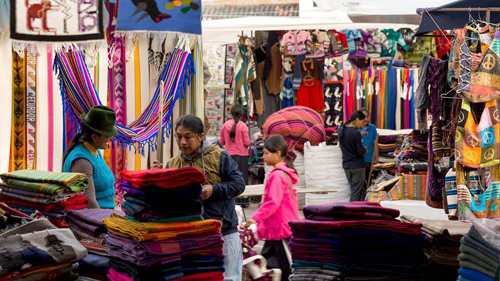Otavalo - world famous indigenous market
Otavalo's beauty lies in its people (the Otavaleño Indians) and their market is undoubtedly one of the most important and spectacular in all of Latin America.
The best day of the week to hit this famous and friendly corner of the Andes is Saturday, the biggest market day for gringos and locals alike.
Arrive Friday afternoon, and then do what most travelers don't: set your alarm for 5:30am. After being jolted out of bed Saturday morning, walk groggy-eyed along Avenida Colon to the river and cross the bridge. Upon reaching the top of Avenida Segundo J Castro you'll find yourself in a scene reminiscent of the pages of National Geographic: the Otavalo animal market.
By 6am, with the sun rising and the mountains casting improbable shadows over the town, the market is already alive with squealing pigs and clucking chickens. Plant yourself on the high grassy bank abutting the market area and watch scenes of unloading, buying, selling and bargaining unfold. Take your camera (you can happily and discreetly snap away from your grassy knoll), but leave your animal rights principles behind, as livestock tender lovin' care is not the highest priority on the day's agenda.
By the time the sun clears the volcanoes at 7am, much of the day's business has already been done, and its time to head back into town to the artesania market.
 The Artesan Market
The Artesan Market
This market is centered around 'Poncho Plaza'. All day long, the whir of cotton candy machines, Andean pipe music, and Quichua, the native tongue derived from the Incan tongue, drift across the square. A blinding maze of colored textiles spills from the square out across town, encompassing the area between Quito and Calderon and Bolivar and 31 de Octubre. As you stroll the streets you'll find everything from jumpers to armadillo shell guitars, wall hangings to ceramic fried eggs. Don't restrict yourself to Poncho Plaza, as you'll probably get better bargains away from the main square (the more items you buy, the lower the prices you can haggle), and the goods on display start to diversify as the market weaves its way through the side streets.
On the stretch of Jaramillo between Quito and Quiroga, mothers and infants share the street with geese, puppies, pigeons and cuyes (guinea pig --a popular local food). Down on Quiroga between Jaramillo and 31st de Octubre (in front of the Plaza de Toros), the ponchos and babywear are supplanted by potted plants, skinned calf heads and bleating goat herds. The northern edge of the textile market is bounded by Calderon, where salesmen extolling the joy of Tupperware stand between stalls of snakeskin, herbal remedies, and bars of magical soap used to ward off jealousy.
A few blocks north, the streets are overtaken by stalks of ripening bananas and pyramids of citrus fruit. The produce market (open roughly the same hours as the Artesanias market) begins on 31st de October at Calderon and runs past the cock-fighting pit (for those with a stomach for this violent and bloody sport, there are regular fights throughout the year) to a covered market bursting with tropical fruit and vegetables. Non-carnivorous folk will have to avert their eyes, as some of the meat stalls -- splattered with eyes, jaw bones, ears and muzzles -- are straight out of Vegetarian Hell. On Plaza Copacabana by the small fun fair and the local train station, there's a smaller but still interesting food market, featuring mountainous piles of potatoes and multicolored sweets.
Otavaleño Indians
Otavaleños have become the most prosperous and possibly the most famous indigenous group in Latin America -- you may have seen them in your own hometown selling their woolen sweaters or strumming Andean tunes. In the past ten years, Otavaleños have begun globe-trotting in a successful campaign to export Andean culture -- and earn big bucks along the way.
In part because of their economic success, Otavaleños have managed to hold on to centuries-old traditions without adopting a 'quick get dressed, here come the tourists' cultural identity. They are proud people and it shows. While other indigenous peoples --under pressure to assimilate-- are donning Levis and tee-shirts, Otavaleños are still easily identified by their distinctive dress: women wear intricately embroidered blouses and a wealth of beaded necklaces, while men have long, braided hair and wear calf-length white trousers, ponchos and sandals.
History has it that Otavaleño Indians have been talented textile makers and businesspeople since ancient times, perhaps even prior to the Incan invasion. It is believed that they migrated to the Otavalo area about 1000 years ago from Bolivia. Under Incan rule in the 15th century, Otavalo became an important administrative center, as new crops and animals were introduced to the area. A year after the Spanish conquest, Ecuadorian land was parceled-out to the Spanish. In Otavalo, Rodrigo de Salazar set up a large weaving workshop (``obraje") on his land; by the mid-1500's it employed hundreds of workers and produced a large share of the textiles used in colonial South America. The Spanish introduced new tools and fibers to the weaving industry, and by the early 1600's, the Salazar workshop had become the most important in the country.
The textile boom in Otavalo really took off in the early 1960's, when Otavaleños working at Hacienda Zuleta began to use weaving techniques introduced from Scotland. And so was born the material known as Otavaleño cashmere, which with its low price and high quality soon found important customers in Ecuadorian cities. The weavers diversified their products and soon established themselves throughout the country. Now, with over 80% of the Otavaleños involved in textile industry, products from Otavalo are found in markets around the world, from neighboring countries such as Venezuela and Colombia to the United States, Europe, and even Asia.